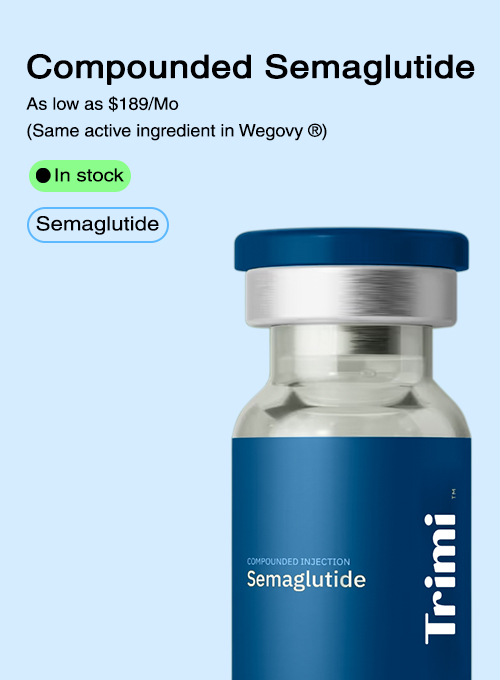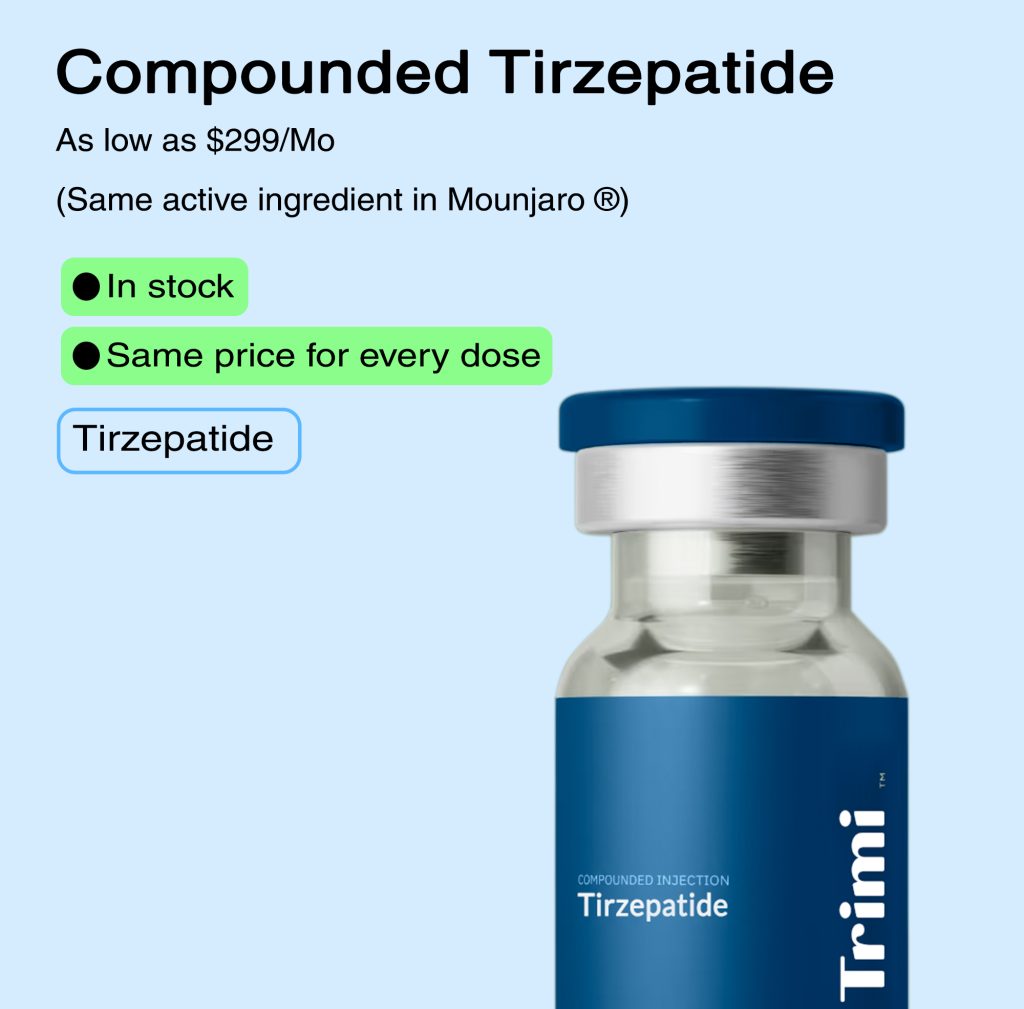Ask ChatGPT
Tirzepatide merges the effects of GLP-1 and GIP hormones to support improved blood sugar regulation and promote weight reduction. Discover how it works, its unique benefits, and how it compares to semaglutide as part of your health journey with TryTrimi.
The U.S. Food and Drug Administration (FDA) has officially removed compounded tirzepatide—the active component found in brand-name drugs like Mounjaro® and Zepbound®—from its shortage list. Due to this, compounding pharmacies in the U.S. will soon no longer be permitted to produce tirzepatide-based formulations.
There is currently a 60-day grace period during which individuals can still consult with their doctors and obtain compounded tirzepatide. After that, compounded tirzepatide will no longer be accessible from pharmacies unless under exceptional conditions.
At TryTrimi, we understand how critical this treatment is for many on their weight loss path. That’s why we’ve partnered with independent medical professionals to offer a solution. For a limited time, you may be eligible for up to a 6-month prescription of compounded tirzepatide. This opportunity is only available for the next 60 days, so it’s important to act quickly and explore your options with a licensed provider.
We’re here to help support your wellness and weight goals during this transition period with care and reliability.
The FDA has confirmed that tirzepatide has been taken off the national drug shortage list. As a result, compounding pharmacies are no longer authorized to manufacture this medication under current federal guidelines.
This means that TryTrimi can no longer provide access to compounded tirzepatide through its partner pharmacies.
We understand how this may raise concerns—especially for users who have relied on this accessible treatment. Please know that we are committed to a smooth and worry-free transition toward other effective treatment alternatives. Read our updated coverage on the recent tirzepatide availability update.
For Current TryTrimi Members: Transitioning to Semaglutide
If you’ve been using compounded tirzepatide through TryTrimi, you may be impacted by this change. We’re working hard to ensure your continuity of care by offering other options, such as compounded semaglutide—the active ingredient in Ozempic and Wegovy.
Why Is This Change Happening?
Tirzepatide gained popularity as a reliable medication for weight control. However, with its removal from the FDA’s shortage list, compounded versions are now federally prohibited. By law, compounding is only allowed for drugs currently listed as being in short supply.
Now that supply issues are resolved, compounding pharmacies must stop producing tirzepatide.
TryTrimi is dedicated to ensuring your care isn’t interrupted. That’s why we now offer access to a range of weight loss treatments, including semaglutide in its compounded form.
Tirzepatide vs. Semaglutide – What’s the Difference?

Both medications are effective in managing weight and regulating appetite by influencing how the body processes sugar.
- Semaglutide mimics the GLP-1 hormone, signaling to the brain that you’re full and helping slow digestion so you feel satisfied longer.
- Tirzepatide performs this same action but also stimulates the GIP hormone, enhancing its effects.
Semaglutide remains a proven and widely-used treatment for those on a weight management plan. It may be an excellent next step in reaching your goals.
What You Should Know
- Cost-Friendly Options: Compounded semaglutide continues to be available and may be a more economical alternative.
- No Service Gaps: We’re doing everything possible to maintain consistent access to your treatments. For any concerns or questions about switching from tirzepatide to semaglutide, contact us via your TryTrimi portal.
- Support Every Step of the Way: Our care team is here to make sure your transition is smooth and well-supported.
We know that changing medications can feel uncertain, but many have experienced success with semaglutide. It may offer you the same level of benefit moving forward.
Note: Semaglutide is only available by prescription after an online consultation. Our plans operate as a subscription service and can be canceled at any time. Medication appearance may vary. The FDA does not evaluate compounded medications for safety or effectiveness. Visit our site for complete safety info.
How to Take Tirzepatide: Dosing & Administration Guide
Tirzepatide is administered once weekly via a subcutaneous injection, meaning it’s injected under the skin—commonly in the abdomen, upper arm, or thigh. It’s available in easy-to-use, pre-filled injection pens, like those used in popular brand-name products such as Zepbound® and Mounjaro®.
Most people begin their treatment at a low dose of 2.5 mg per week, with the potential to gradually increase to a maintenance dose between 5 mg and 10 mg—though some may go up to 15 mg depending on individual needs and tolerability.
Suggested Tirzepatide Titration Schedule
Tirzepatide is typically titrated—meaning the dose is slowly increased over time to reduce side effects and find the right balance for your body. A common dosing plan looks like this:
- Month 1: 2.5 mg
- Month 2: 5 mg
- Month 3: 7.5 mg
- Month 4: 10 mg
Healthcare providers may adjust this plan based on how you respond to the medication.
What Is Titration and Why Does It Matter?

Titration refers to the gradual adjustment of a drug’s dosage. In the case of tirzepatide, starting at a low dose and slowly increasing it can help minimize side effects like nausea or digestive discomfort. This step-by-step approach helps your body adjust to the medication while still delivering results.
Most patients increase their dose every four weeks under the supervision of a healthcare provider until the optimal dose (5 mg to 15 mg) is reached for sustained benefits.
Tirzepatide vs. Semaglutide: What’s the Difference?
Both tirzepatide and semaglutide are GLP-1 based treatments designed to support weight loss and regulate blood sugar levels. However, tirzepatide stands out by also targeting GIP receptors, giving it a dual-action advantage.
Studies—including one published in the New England Journal of Medicine—have shown that tirzepatide leads to greater weight loss compared to semaglutide, making it a strong contender for those looking to improve both metabolic and weight-related outcomes.
That said, both medications can have similar side effects—mostly mild gastrointestinal issues such as nausea or diarrhea. Tirzepatide may have a slightly higher chance of more intense side effects at larger doses.
Ultimately, the best option depends on your body’s response and personal preferences. Your provider can help decide which therapy fits best into your plan.
Always Talk to Your Doctor First
Before starting tirzepatide—or any prescription medication—it’s essential to speak with a qualified medical professional. Your health history, current medications, and personal goals all play a role in choosing the right treatment path.
At TryTrimi, we make it easy to connect with licensed healthcare providers who can guide you through a personalized plan. FDA-approved options like Zepbound® and Mounjaro®, as well as compounded tirzepatide, are available online for eligible users.
Get Started With Semaglutide
If tirzepatide isn’t right for you, or you need an alternative, semaglutide is also a trusted option for long-term weight support. Talk with your provider to explore what’s best for your health needs.
Disclaimer
The content provided here is for informational purposes only and is not meant to replace professional medical advice, diagnosis, or treatment. Always consult a licensed healthcare provider before starting or changing any medication.
Please note that compounded medications are not evaluated by the FDA for quality, safety, or effectiveness. Your prescription and health plan must be determined by a licensed provider through consultation.
TryTrimi does not manufacture, own, or dispense medications. All prescriptions are written by independent licensed providers and filled by state-licensed pharmacies.





